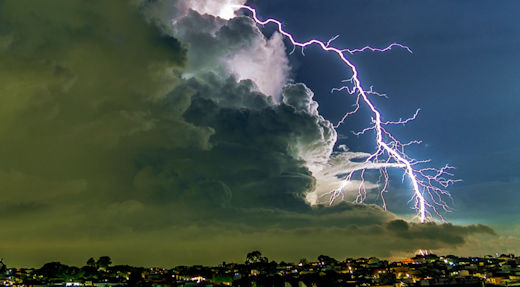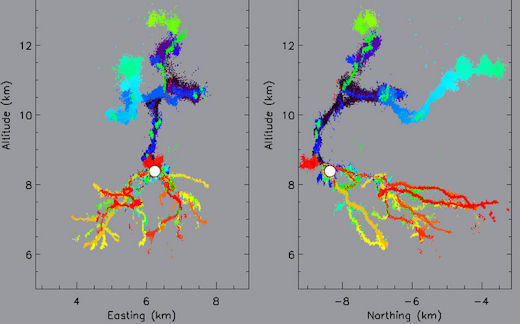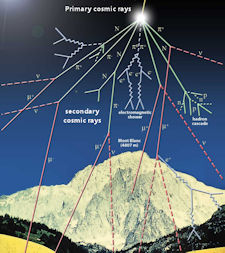NEW EVIDENCE THAT COSMIC RAYS SPARK LIGHTNING: Every second, almost 50 bolts of lightning zig-zag across the skies of Earth. Despite centuries of study, however, researchers still aren't sure how the bolts get started. Electric fields in thunderclouds are often too weak to ignite a powerful discharge.

A lightning bolt over Brazil. Photo credit: Sergio Mazzi
A new study just published in the Journal of Geophysical Research may have solved the mystery.
"We believe that that most lightning flashes in thunderstorms are ignited by cosmic ray showers," says the study's lead author Xuan-Min Shao, a senior scientist at the Los Alamos National Laboratory in New Mexico.
To investigate the earliest moments of lightning formation, Shao and colleagues built a radio interferometer named "BIMAP-3D." Consisting of an array of 8 antennas in Los Alamos, BIMAP-3D can make three dimensional images of lightning and pinpoint the bolts inside thunderclouds. Here's an example:

Caption: Colors in the image represent time. Blue traces the earliest moments of the bolt, while red denotes the end.
This is a lightning bolt from a massive thunderstorm that passed by Los Alamos on July 30, 2022. BIMAP-3D imaged more than 300 bolts during the 90-minute storm. It was a treasure trove of data.
The experimenters realized that some of the bolts they observed happened in parts of the storm where electric fields were too weak to cause the "Initial Breakdown Event" (IBE)--the initial spark that sets the lightning in motion. Modern theories of relativistic electron avalanche couldn't explain what they saw. Their suspicions soon focused on cosmic rays.
Cosmic rays are high energy particles that come from distant supernova explosions and other violent events across the cosmos. They strike Earth's atmosphere all the time, creating a secondary spray of particles called "cosmic ray showers." Regular readers are familiar with these showers because we routinely monitor them using Earth to Sky cosmic ray balloons over California.
 One of the important things about cosmic ray showers is that they contain antimatter--positrons as well as ordinary electrons. The Los Alamos 3D lightning maps contained strong evidence for positrons. Electrons and positrons are bent in opposite directions by Earth's magnetic field, so they leave opposite imprints on the lightning's polarization, which BIMAP-3D also measured.
One of the important things about cosmic ray showers is that they contain antimatter--positrons as well as ordinary electrons. The Los Alamos 3D lightning maps contained strong evidence for positrons. Electrons and positrons are bent in opposite directions by Earth's magnetic field, so they leave opposite imprints on the lightning's polarization, which BIMAP-3D also measured.
"It took me a while to figure this out," admits Shao. "I started with electrons only at the beginning, but could not explain the observations. With both electrons and positrons involved, all the observations can be consistently explained."
Positrons clinched the case for cosmic rays. "The fact that a cosmic ray shower provides an ionized path in the cloud that otherwise lacks free electrons strongly favor the inference that most lightning flashes are ignited by cosmic rays," the authors wrote.
In fact, it's still unclear how much of Earth's lightning is sparked by cosmic rays. Many more storms need to be studied with this method to improve the statistics. "This will require a lot of long-term and good quality lightning data," Shao says.

Geen opmerkingen:
Een reactie posten